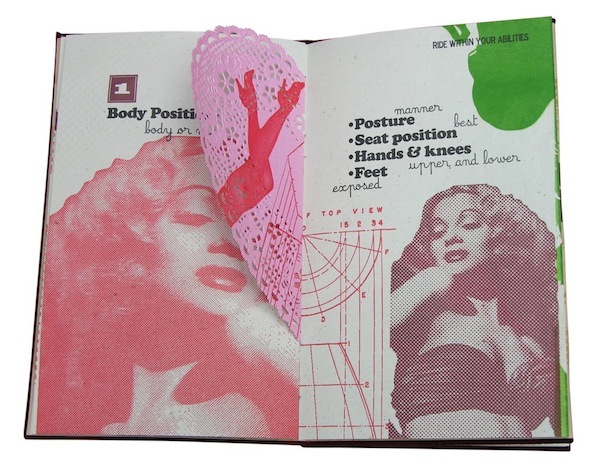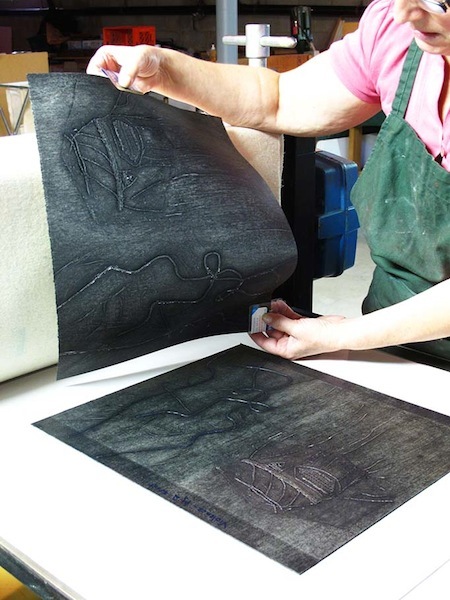Women and the Artist's Book
Curatorial essay by Catherine E. Doubler
Many of the books highlighted in The Artists’ Books Showcase were created by women, and this indicates a trend within the book arts of the past few decades. The field of artists’ books has been dominated by women, and scholars and curators are beginning to take notice and speculate as to why this may be. The Book as Art: Artists’ Books from the National Museum of Women in the Arts contains essays by Judy L. Larson, Audrey Niffenegger, and Johanna Drucker on this very topic. Larson and Drucker both argue that women artists are disposed to making books: women have an "attraction to storytelling, intimacy, and collaboration" (Larson 9), or that the activities behind making an artist’s book "are in many ways connected to the traditionally sanctioned women’s pursuits of keeping diaries, sewing, fancy needlework, elaborate decorative tasks, and the careful preservation of memory" (Drucker 14). However, women book artists subvert and/or transform these traditional women’s activities, both in their bookmaking and in the content of their books.
Ellen Knudson’s Wild Girls’ Redux: An Operator’s Manual is based off of an earlier book Knudson printed that included a list of instructions for becoming a "wild girl." Wild Girls’ Redux revisits many of the same themes of the earlier book: women’s self-fashioning, sexism, and female body image. The binding is in the form of an accordion portfolio, with two pamphlets sewn into the binding. These pamphlets contain rather disparate items; pink heart paper doilies, white doily placemats, flocked paper covers, and green office ledger papers are printed over with text from a motorcycle operating manual and photographs of 1950s pinup girls. Feminine doilies are juxtaposed with office ledgers; machinery is juxtaposed with images of the female body. The motorcycle driving and safety instructions are transformed within the context of this book, becoming tongue-in-cheek instructions on how to handle a woman’s body: "Become familiar with the equipment;" "Be resistant to penetration;" "Use caution and squeeze—never grab." Knudson reshapes the significations of the materials in her book in order to discuss gender dynamics and expose sexism.
Knudson exposes how the female body is often fragmented into parts for male consumption. Julie Shaw Lutts also comments on this fragmentation in her one-of-a-kind book Alterations and Adjustments. Like Wild Girls Redux, Alterations and Adjustments makes use of schematics, but Lutts incorporates sewing patterns into her work. These patterns, mixed together with vintage photographs, form twenty hand-sewn collage pieces with vintage zipper pulls at the top of each piece. These collage pieces act as the "pages" of the book and are housed inside a vintage wooden box that Lutts has decorated with fabric and buttons. When one turns these collage pages over, one sees that they become pieces of a puzzle called "Pattern for Success." The pieces show the body parts of four female figures. Once the puzzle is put together, arrows point to two of the women to show what "ideal" feminine traits should be a part of this pattern for success: desirability, a husband, responsibility, and so on. Lutts's book reveals how straitjacketed women were in the 1940s and 1950s. What is more, she makes use of sewing in ways that resist the gender normative use of sewing presented in her book. Lutts reinvents this activity, making a domestic activity such as sewing a source of female empowerment.
Many women book artists ponder the history of sexism and misogyny through their work. Papermaker Robbin Ami Silverberg has created a number of books that deal with women’s issues, such as The Four C’s. This book is one in Silverberg’s Semper Tedium series, which is comprised of albums of textile swatchbooks with proverbs about women printed onto the individual swatches. The swatches are not actually made of fabric, but Silverberg’s paper. The Four C’s holds four swatchbooks that contain proverbs about a women’s activities: cookery, cleaning, childcare, and crafts. The proverbs are intensely hostile to women: "A womb makes the woman;" "Spinning, crying and talking about her husband is often all a wife can do;" "Woman is man's soap." On her website, Silverberg states that the "pleasing aesthetic results" of the book "are in striking contrast to the content of" the vitriolic proverbs. These snippets of misogynist discourse correspond to the function of textile swatches: they are samples and representative pieces taken from the larger fabric of women’s oppression. Swatches are also disposable, and by printing these proverbs onto swatches, Silverberg enacts a form of protest in which the swatchbooks, and the proverbs contained within them, can be looked upon as collections of patriarchal refuse.
While Silverberg’s book shows the language of misogyny, Maria G. Pisano’s Viva Voce honors the words of women. This piece contains four booklets of landays, which are Persian poems sung by Pashtun women. The booklets catalog the songs by theme—love, violence, war, and exile—and provide relief printed images that are responses to the poems. Pisano makes use of pop-up elements and folded papers that can make it difficult to open the book completely or to locate the poetry. This kind of struggle mimics the distress heard in the songs. "Violence" contains a landay about a woman in love with a man other than her husband: "Give me your hand, my love, and let us go into the fields / So we can love each other or fall together beneath the blows of knives." "Exile" speaks of a Pashtun woman’s expulsion from her homeland of Afghanistan: "My beloved, my sun, rise above the horizon and obliterate my nights of exile. / The darkness of solitude cloaks me from all sides." Eroticism and suffering often interact in these songs, which also explains the recurring juxtaposition of deep red and black colors in this powerful book.
As these few examples show, women book artists do make use of materials and crafts that have been socially coded as feminine: Lutts incorporates sewing into her work, Knudson repurposes doilies, Silverberg makes her books out of "fabric" swatches. However, women book artists also recode these activities and objects, making them tools that give women a voice and that symbolize women’s empowerment, not their oppression.
Sources:
The Book as Art: Artists’ Books from the National Museum of Women in the Arts
Website for Ellen Knudson's Crooked Letter Press: http://crookedletterpress.com/#/wild-girls-redux/
23 Sandy website for Julie Shaw Lutts's Alterations and Adjustments: http://gallery.23sandy.com/uncommon-threads/shawlutts/
Website for Robbin Ami Silverberg: http://www.robbinamisilverberg.com/FourCs.html



